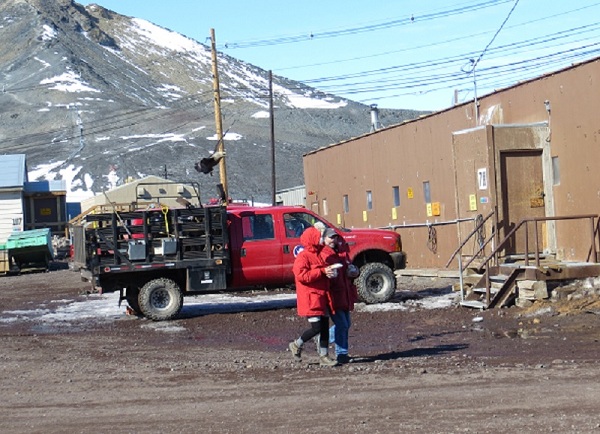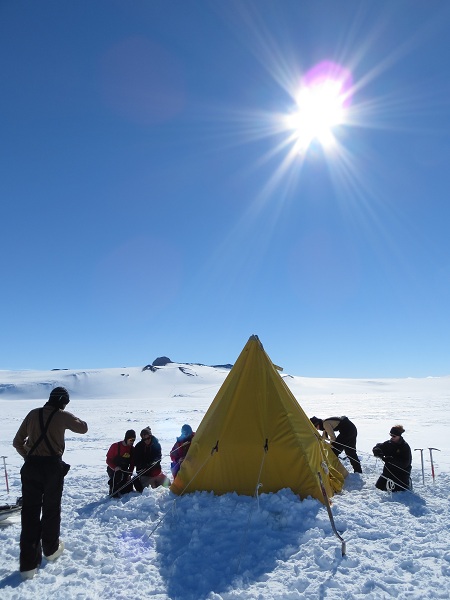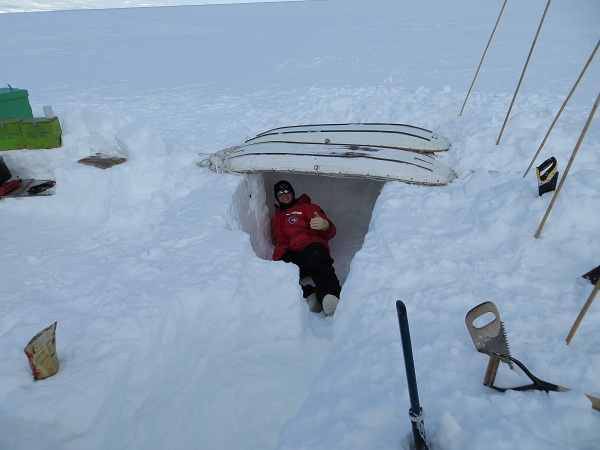Hey all. It’s time for another update. I’ve survived Snow School (aka Happy Camper) and figured I’d tell the tale of it. So I will do that for point 1. As for 2, regarding the other work Lee and I have been up to, I’ll get into all the training sessions and meetings I’ve had to go to, and plans for tomorrow and the upcoming week. First, a shpeal on the weather.
The weather has been great here. Temperatures during the days have mostly held in the mid- to upper-20s. Only a couple days have been windy, while the rest have been calm. There is talk of some snow tonight, but that should be light. Hopefully the weather can cooperate for our (fingers crossed) first flight out to the field by the end of this week or early next week (if all goes well). It certainly did cooperate for Snow School…
1) From 30 November to 1 December, I went to Snow School, which is necessary for people who are going to work out in the field (our work will be going out in the field to work on our AWS). The training began with some in-class activities on the morning of 30 November, led by our instructor Suz Detweiller. We went through introductions, overviews of outdoor safety, and a case study of how things can go wrong when you’re out in the field in harsh weather conditions. Once we got that done, we all packed up our personal gear as well as the supplies we needed to bring out there, like stoves, food, etc, and headed out to our site where we would be camping. This was on the McMurdo ice shelf, north of Scott Base and the pressure field.
We took our favorite vehicle, the Delta, out there, and here’s a picture of us unloading our gear:
After that, we all met in the I-Hut (Instructor’s Hut) to go over some final preparations for our stay outside for the remainder of the day until the following morning:
One thing Suz especially emphasized was for us to eat plenty of food, drink plenty of water, and keep moving. This would help us stay as warm as possible. Throughout the day, we would take 5 or 10 minute food breaks to keep our metabolism high and our bodies warm.
Then, it was off to our camp site! It is called Snow Mound City, named thusly because they used to have people build “igloos” of sorts, and hence the snow mounds.

Our walk to Snow Mound City, with Suz in the front of the pack on the skidoo transporting our bulky gear
Along the way, we stopped at the supply hut, where we retrieved our tents, flags, stakes, etc, and brought those to camp. The first thing we did when reaching camp was putting up one of the tents, and I think we did a fine job:
One very important thing we learned about setting up tents is to use deadmen. These are sticks, stakes, or any straight rod that you bury in the ground near the tent, with ropes, which are attached to the tents, wrapped around the item you buried. This keeps the tent stationary so it doesn’t blow over in the wind. They work incredibly well.
Suz then showed us how to build snow blocks for our wall to block the wind, aided us in building another tent, and provided some last minute advice. At around 5 om that night, we were on our own until morning. We all worked hard to transform what was just a simple, flat snow surface into this:
As you can see in the picture above, we set up 4 tents total. We built a wall made out of blocks of snow that was intended to block the wind from the tents. Unfortunately, as indicated by the flags, we should have put the tents on the other side of the wall. Around 3 in the morning on 1 Dec, the wind shifted slightly from approximately northerly to northwesterly, and it picked up speed. It was amazing how rapidly it shifted. It was as if someone flipped a switch.
The “kitchen” was where we did, as you may have guessed, all of our cooking. We had three stoves running, with two large pots of hot water. This enabled us to have drinking water, coffee, tea, oatmeal, and the frozen meals for dinner. This whole experience went by fairly smoothly because we all were really good at working together as a team. No one was slacking off too much, and everyone was willing to do their part to make everything run smoothly. That really helped to make it an enjoyable experience.
Suz gave us a VHF (very high frequency) radio so we could radio in to her to check in at times we established, and to use if there was an emergency. I volunteered to use it, so that night I radioed in. There were some clouds approaching, most likely due to a warm front from a cyclone to our west (which would explain the winds), so I asked her to get a forecast from Mac Weather. Luckily, there was only cloudiness and some wind, but no snow, or whiteout conditions, or anything.
I was very curious about the weather because I planned on sleeping outside that night. I did not want to get snowed in to my trench! After hearing that forecast, I felt much more comfortable in sleeping in my trench that night. And here are the sleeping quarters I made for myself:
It took me a while to get all of my sleeping gear set up, but once I got settled in, the trench worked pretty well. I and another member of our group were the first to get up the next morning, around 4:30 am, and we prepped hot water for everyone. A few hours later, we all packed up everything and tore down the campsite. Our last few exercises involved using an HF (high frequency) radio, building a camp as quick as we can, and how to rescue someone in whiteout conditions. For that last one, we wore white buckets on our heads (yes I’m sure it looked hilarious) and used a rope that we all held on to so we would know where everyone is as we ventured out to rescue that person. It was almost impossible to see, very hard to talk, and very scary. It would be nearly impossible to go anywhere in whiteout conditions.
Once we were done in the field, we went back to go over some final items, and then we were done. I graduated Snow School, and I had a blast doing it.
2) Another training that I’ve done is light vehicle training. This is so I can drive trucks, primarily to move cargo from the cargo yard to Crary Lab.
I had to pause on writing this post because I had to go to snowmobile training, and this was almost as fun as Snow School. First we talked about the safety aspects of riding snowmobiles, went over the different parts of the vehicle, and finally went out in the ice to drive them. That was my first time driving a snowmobile, and it was a blast. Our instructor, Dale, was a very nice guy and was kind enough to take a picture of me on my beast of a ski-doo:
Now that I have all that knocked off the to-do list, Lee and I just need to have some meetings about helo and twin-otter flights, and hopefully we can get out to our first weather station at the end of this week!
I’ll wrap this post up there, and come by with more updates later.
Dave
….and I’ll close with a picture of a skua attack (no injuries). And yes, I was waiting for it to happen so I could capture it 🙂











